Mkhuze Game Reserve in northern KwaZulu-Natal has many reasons to draw visitors, but watching the animals visiting the reserve’s KuMasinga Hide watering point is always one of its highlights.
This is the last of three posts recalling trips away from home to coincide with our cancelled holiday. This week I decided to stay within my home province and share a visit to one of my favourite nature reserves, one that I first visited when I was a child. Mkhuze Game Reserve forms part of the iSimangaliso Wetland Park.
KuMasinga Hide is situated in beautiful sand forest, one of several distinctive habitats that constitute Mkhuze’s remarkable diversity. From the slopes of the Lebombo mountains down to the Mkhuze river, wetlands and pans, including the large iNsumo pan, visitors can experience a mosaic of vegetation types that include the sand forest, grasslands, acacia savannah, woodlands and riverine forest including an ancient sycamore fig forest on the banks of the river.
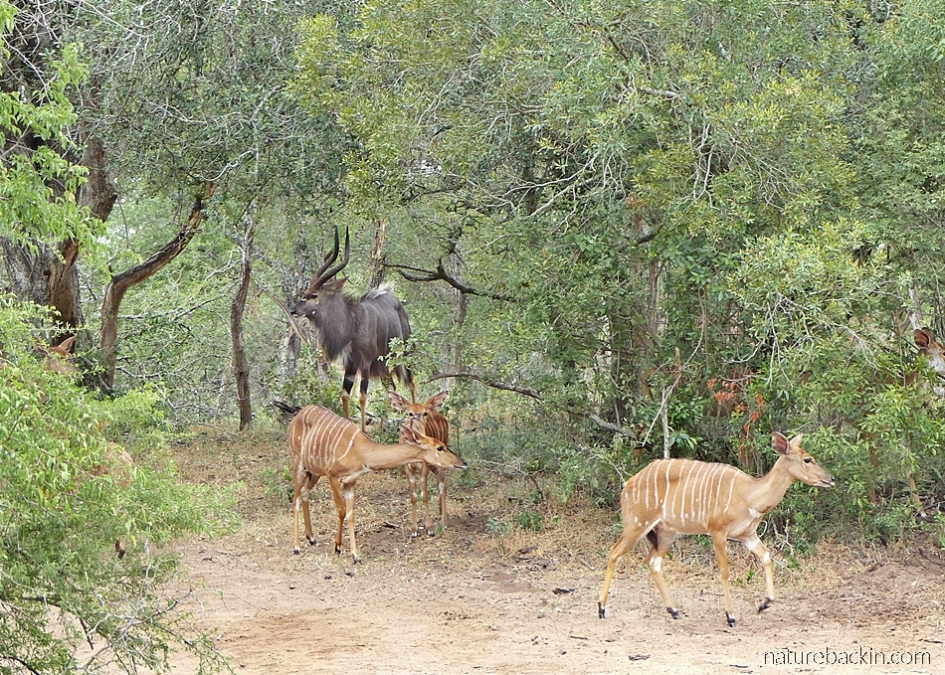
Nyala antelope emerging from the sand forest as they approach the KuMasinga waterhole
I decided to focus on just one dimension of Mkhuze’s riches, and all of the photos were taken from the KuMasinga Hide. Apart from the photo below that was taken in 1973, all the other photos were taken during a three-day visit to the reserve in January 2015.
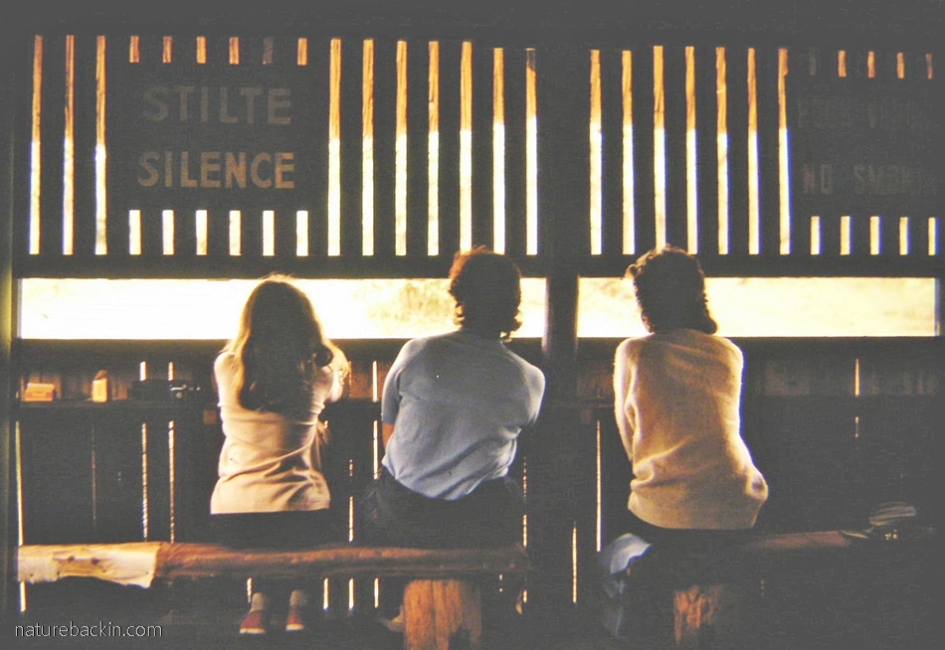
A photo my father took of my sister, mother and myself (on the right) in KuMasinga Hide on a family visit to Mkhuze back in 1973. This photo is copied from a slide
Although the photos may give the impression that the waterhole is very busy it is usually a peaceful place, a good spot to sit meditatively and listen to the birdsong. It is at its busiest during the drier winter months or during periods of drought, and at any time of the year it is most popular with animals needing to drink in the late morning and perhaps followed by the late afternoon. As for nocturnal visitors, we can only guess.
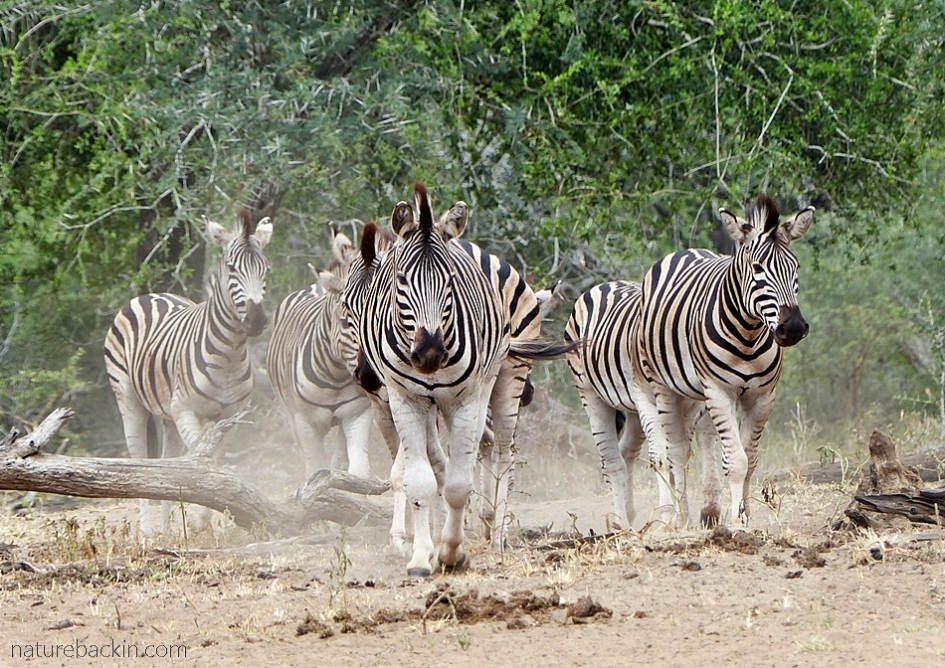
There is always a degree of excitement when animals emerge from the sand forest to go down to the water to drink. As these zebras eagerly approach, their hooves raise dust from the sandy ground
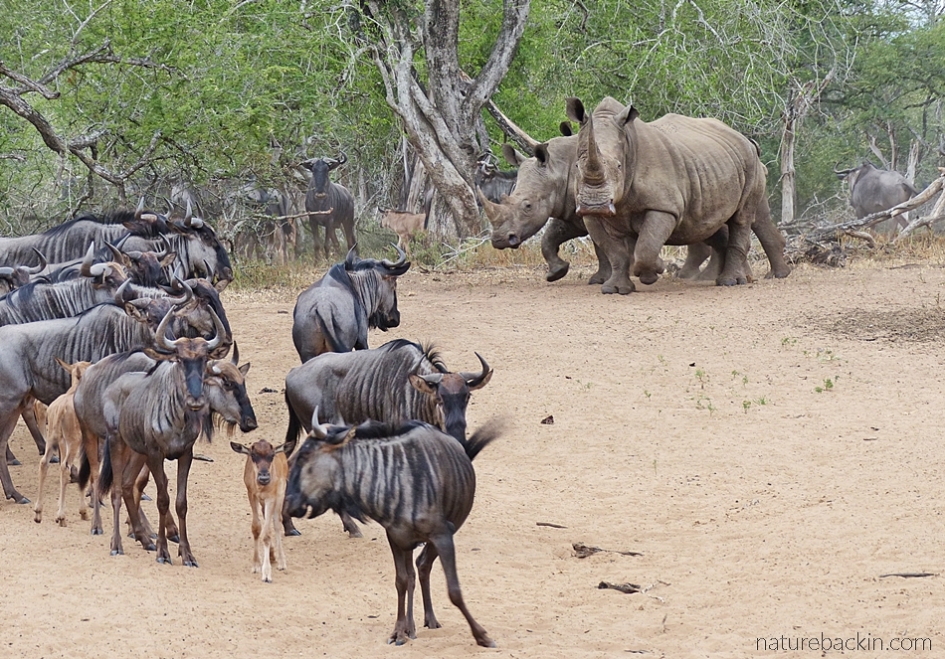
With their audible hoof beats when they are running and their loud bleats and grunts the wildebeest are usually the noisiest of the animals coming down to the water. By contrast, the large white rhinos are among the quietest
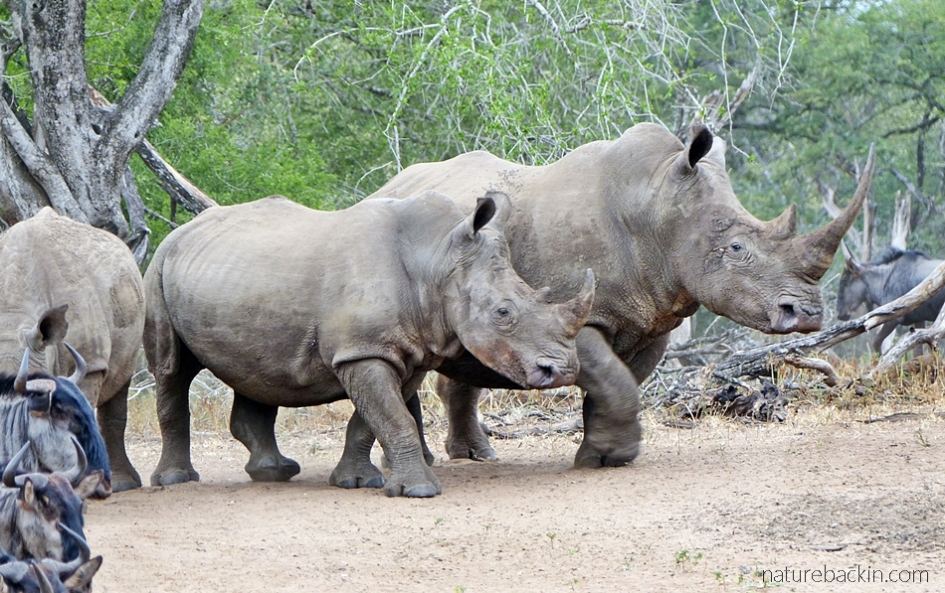
With their bulky bodies and limited facial expressions rhinos can be hard to read, but even so their buoyant walk conveys something of their anticipation as they approach the water
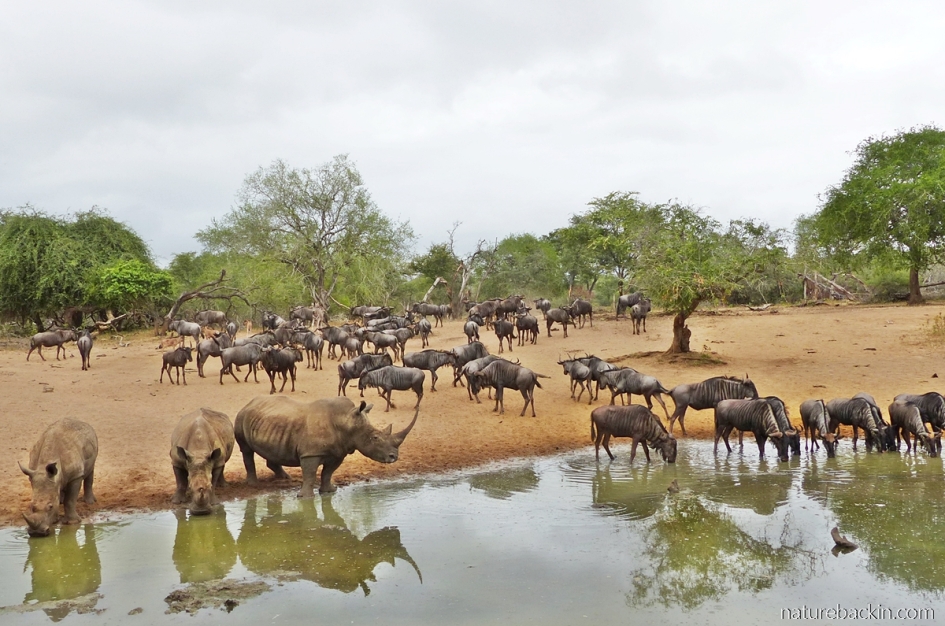
The waterhole at the busiest times of the day is teeming with animals coming down to drink
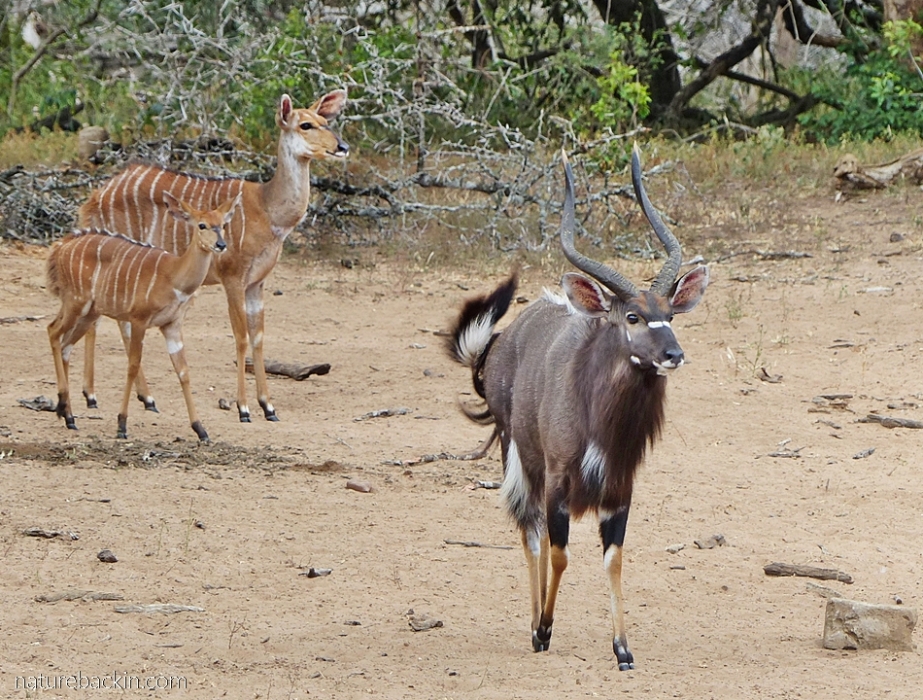
Despite the business and the constant comings and goings of a variety of species, these nyala display their customary caution
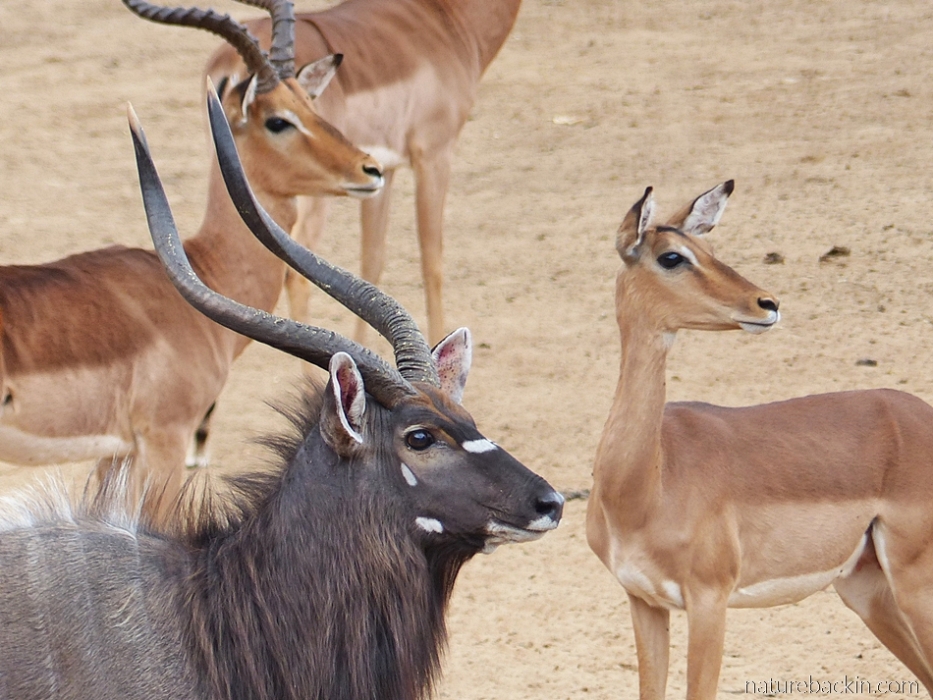
On this morning the wariness is palpable
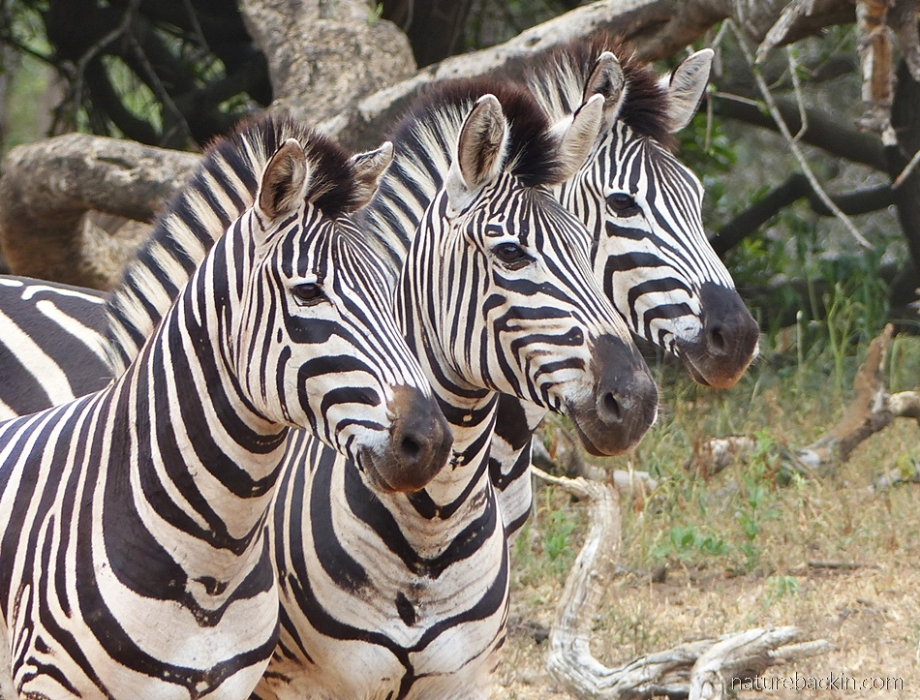
The tension in these zebras causes them to adopt identical postures
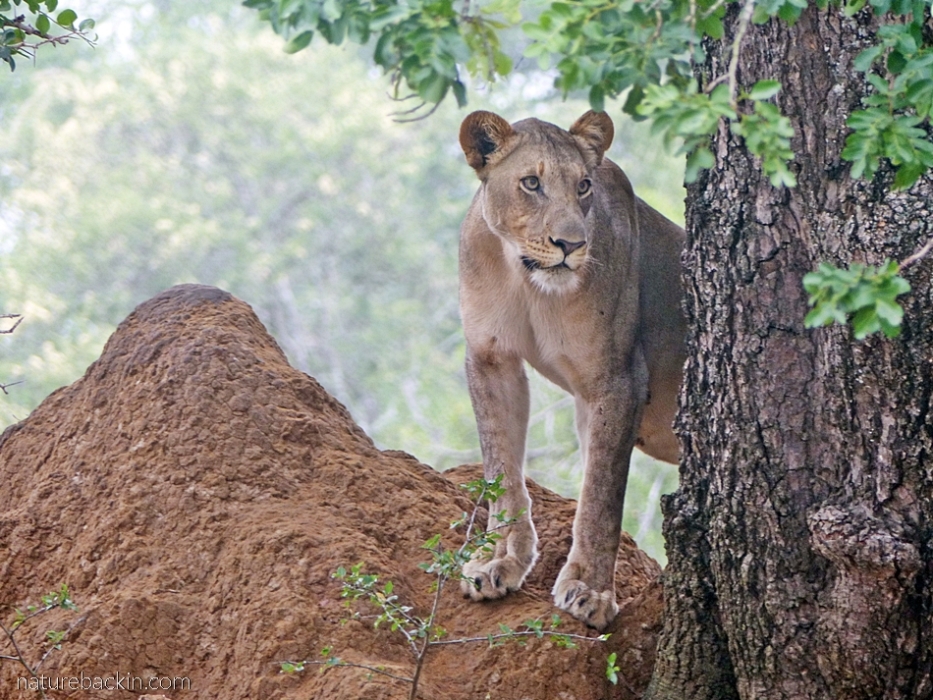
And this is why the animals are more alert than usual. Lions are at the waterhole
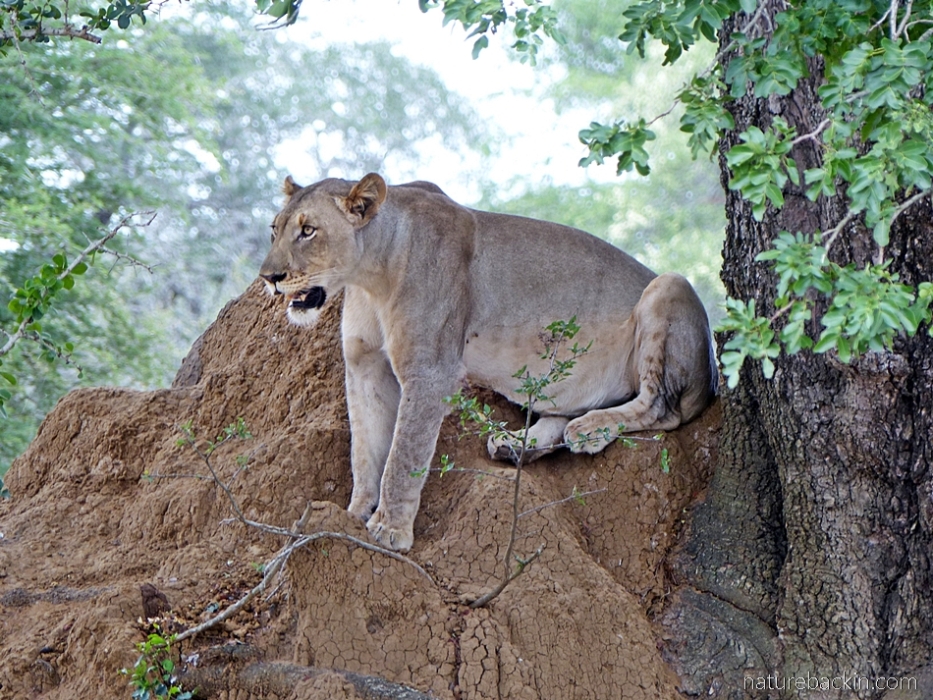
Judging from her bulging belly this is not a hungry lion, but she and others from the pride are still a reason for caution. She spent much of the morning keeping an eye on the waterhole from the vantage point of an anthill

No wonder this vigilant zebra pauses on its approach to the water, riveted to the spot
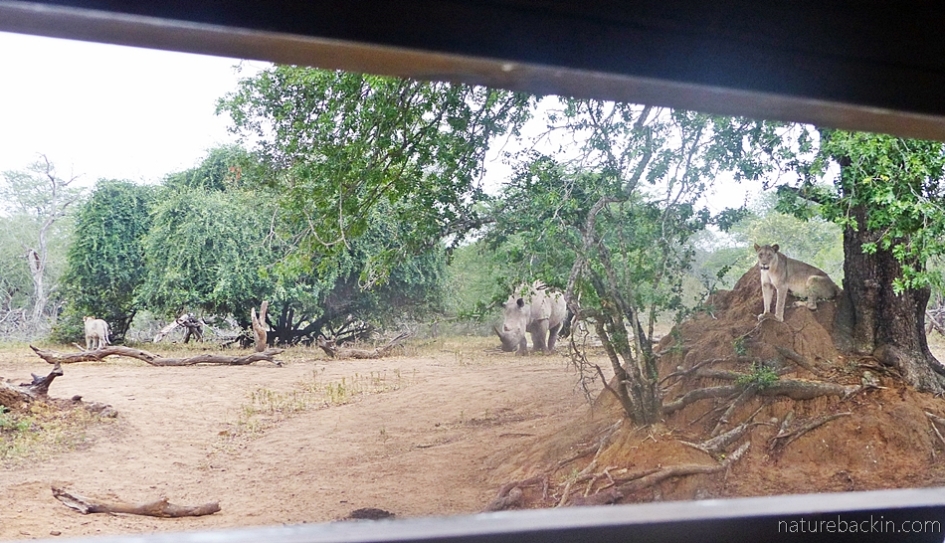
This wider-angle shot from the hide shows the lioness on the anthill watching the waterhole as a rhino approaches. A second lioness can be seen further to the left
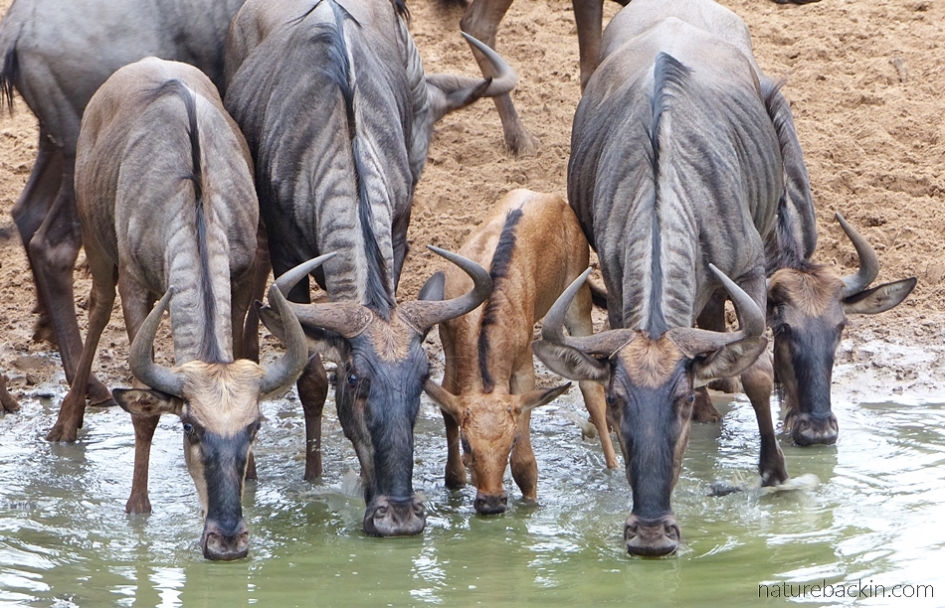
Most animals tend to keep bunched closely together while they are drinking. Here a wildebeest calf stays close to the adults – safety in numbers
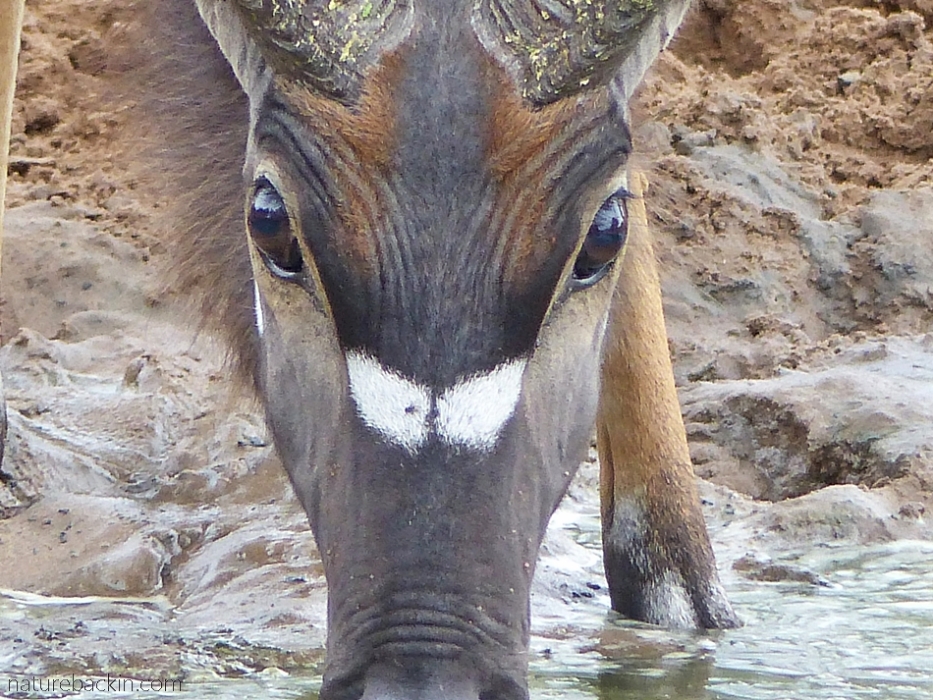
While drinking this nyala ram remains wary and alert
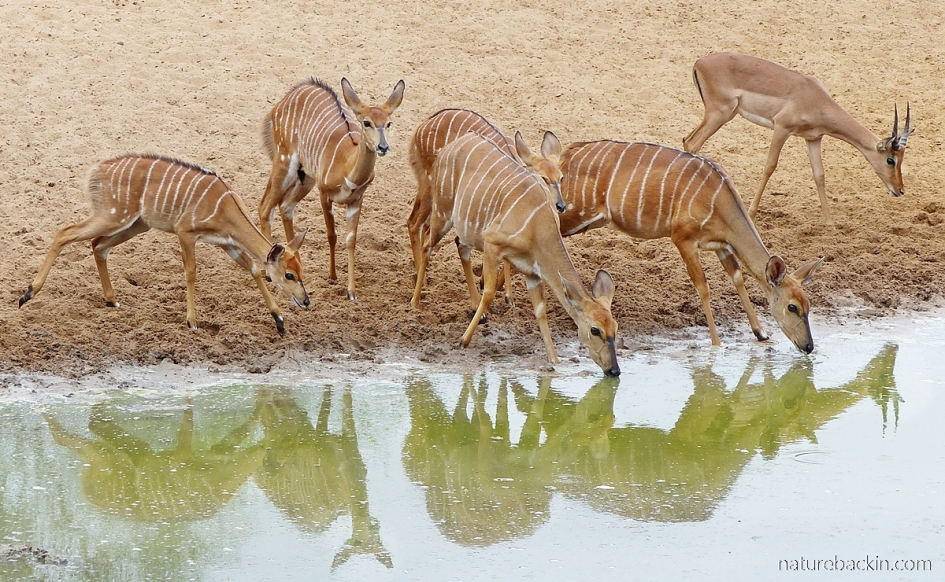
A young impala ram associates with a group of female nyalas as they drink at the waterhole
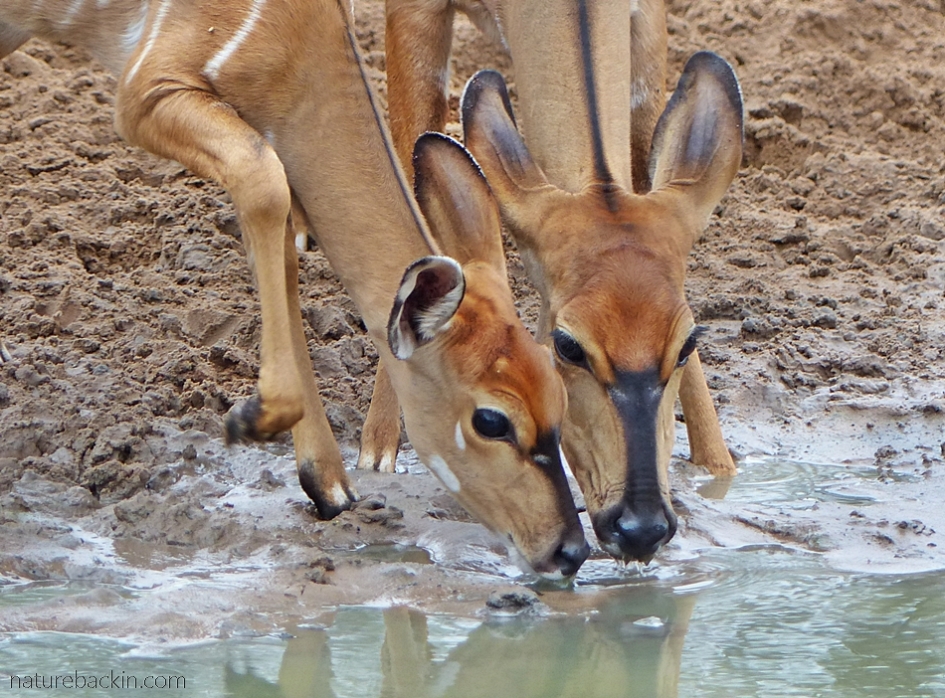
Keeping close, two nyalas share a drinking spot

Zebras also keep together while drinking warily
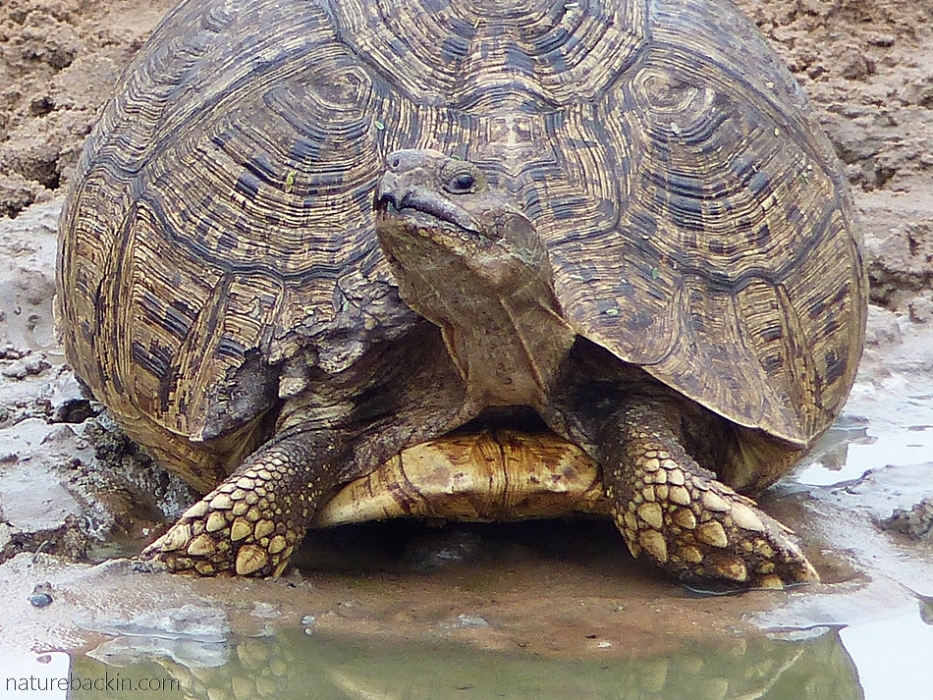
After a long slow approach down the sands towards the water, this tortoise took its time seemingly relaxed while savouring each mouthful of water
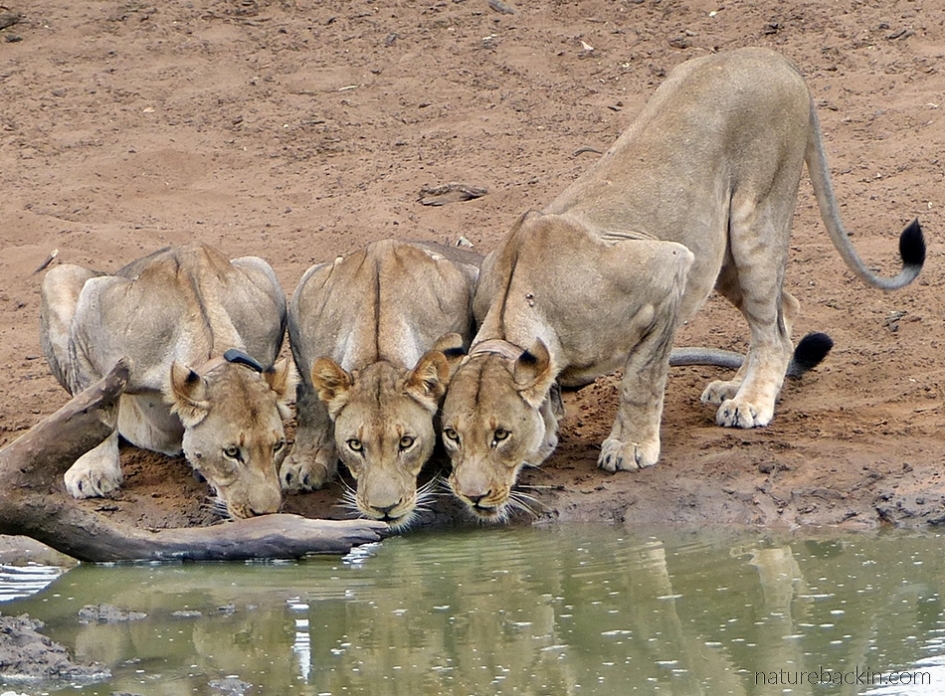
Lions get thirsty too! Two of these three lionesses wear collars to enable them to be monitored by satellite tracking
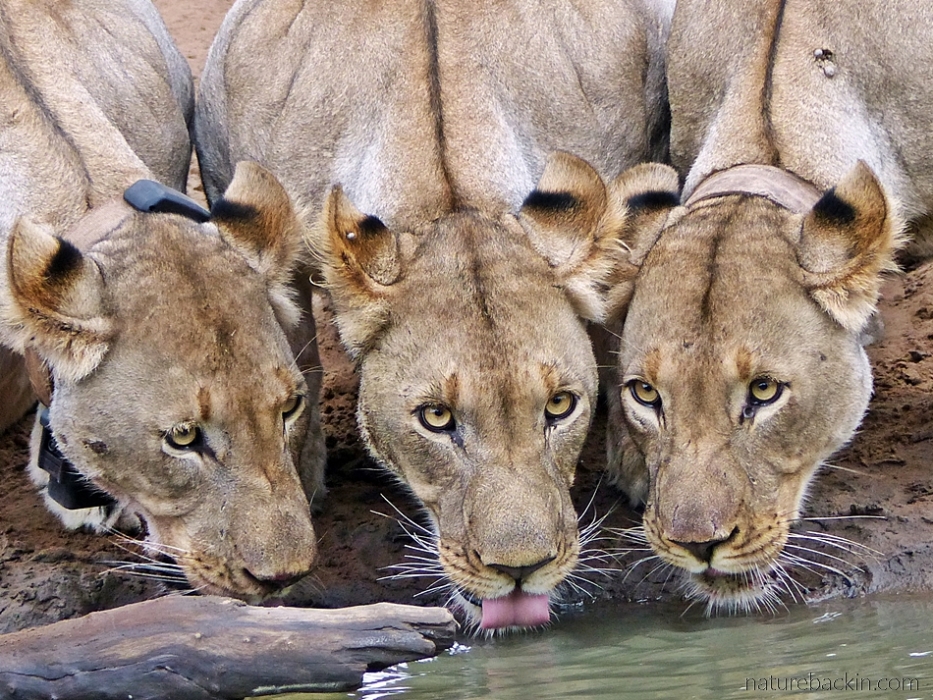
It would appear that even lionesses have a preference for safety in numbers while drinking
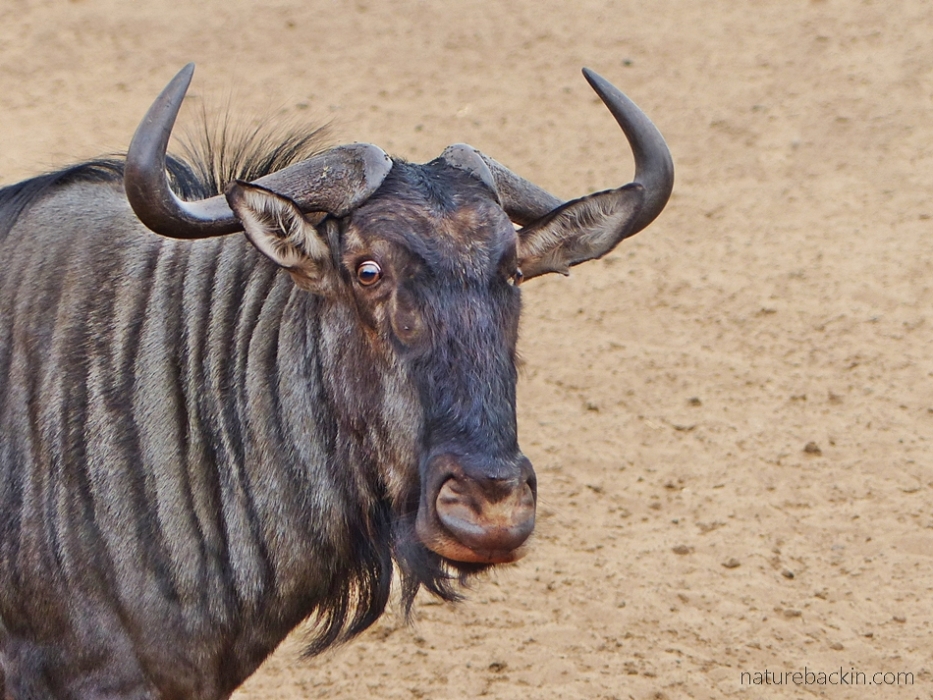
An expressively wild-eyed blue wildebeest (brindled gnu)
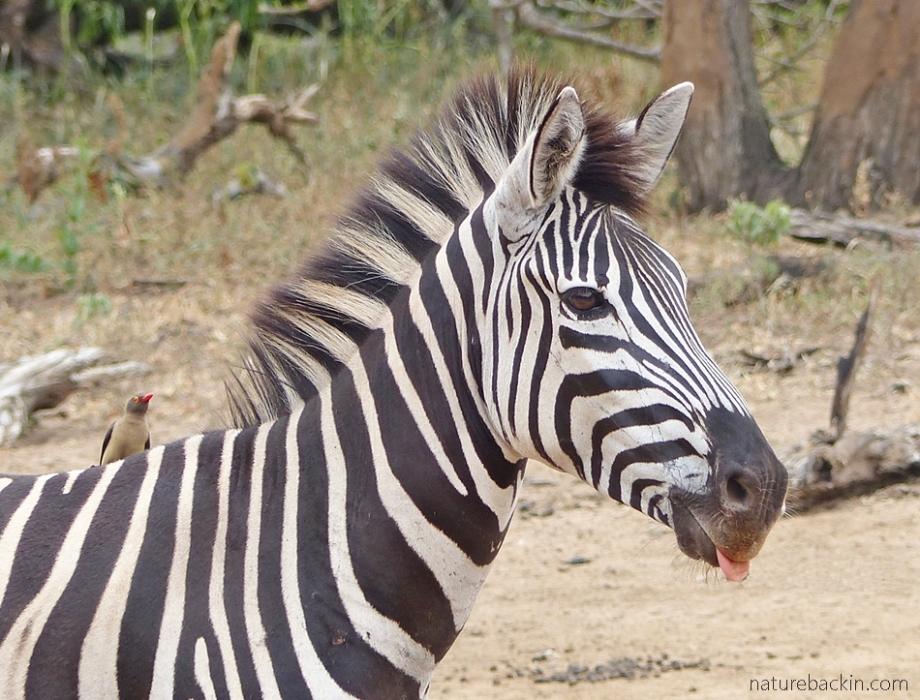
Amidst the hubbub a red-billed oxpecker keeps a grip on the situation, while the zebra with its tongue out looks a little discombobulated
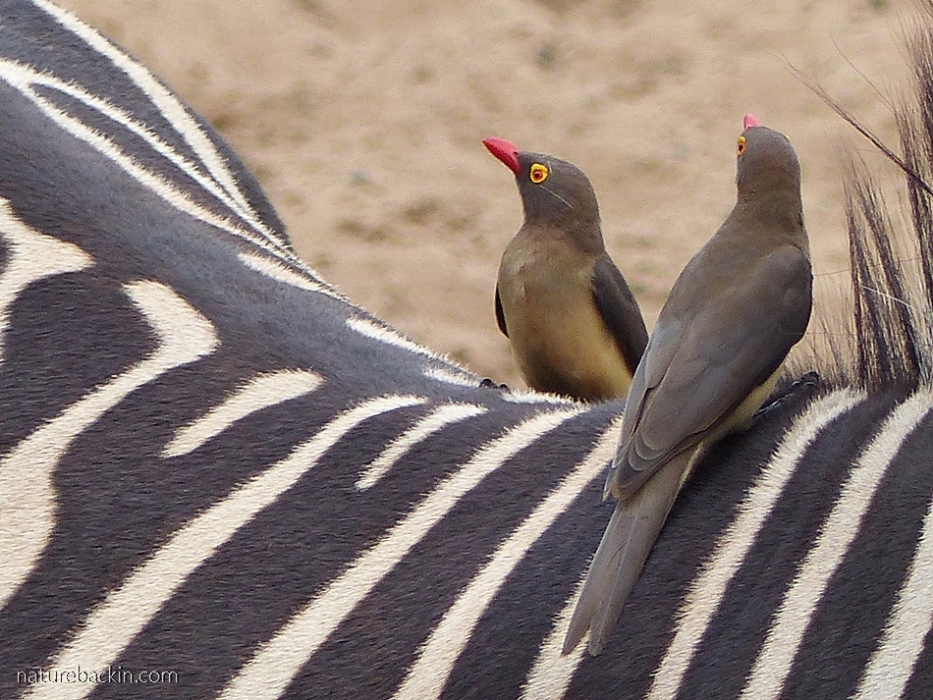
Short legs and strong feet with claws enable oxpeckers to hang on, often using their tails to help them balance. A flattened bill enables them to scissor through fur looking for ticks and other parasites on the skin of the large mammals that host them
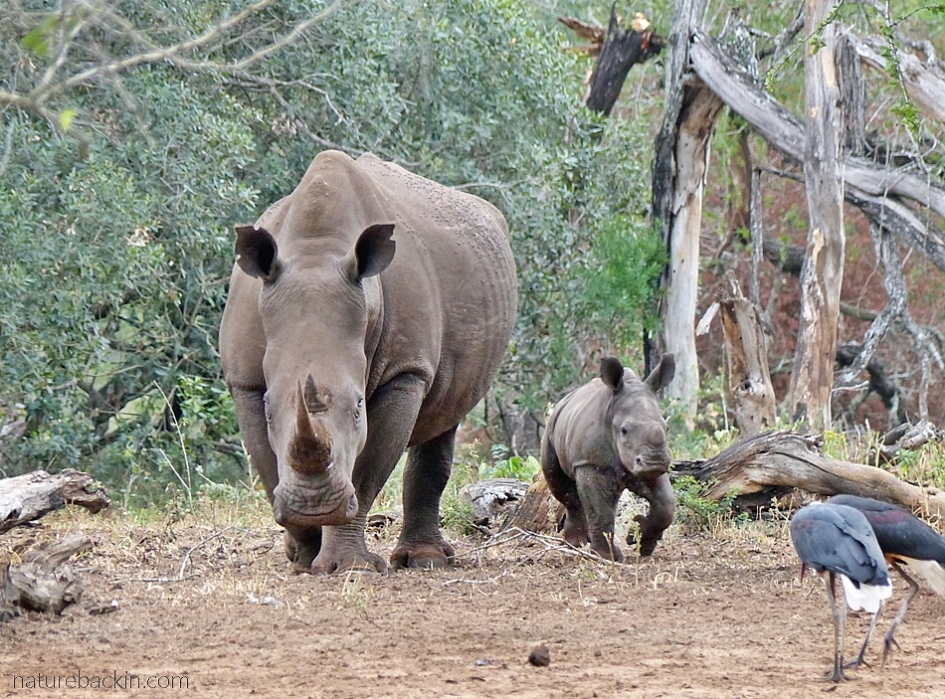
A white rhino with a young calf come down to the water, watched by a pair of woolly-necked storks
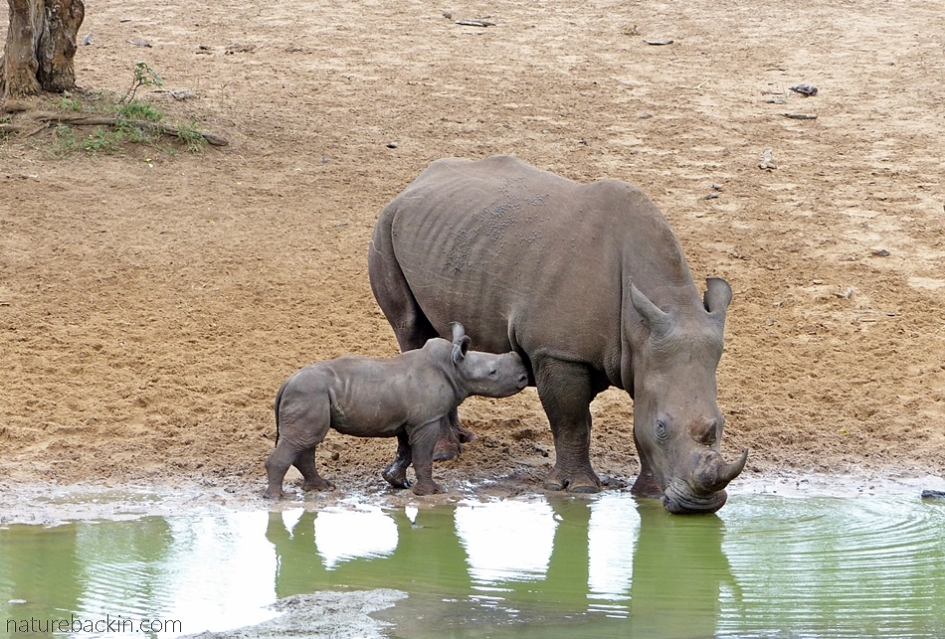
Only the mother needed to drink. White rhinos start grazing at around two months old, but may continue suckling up until they are about a year old. Sadly, another white rhino and her calf were killed by poachers elsewhere in the park on the day that this photo was taken

A woolly-necked stork took a drink in the earlier part of the morning before it got too busy
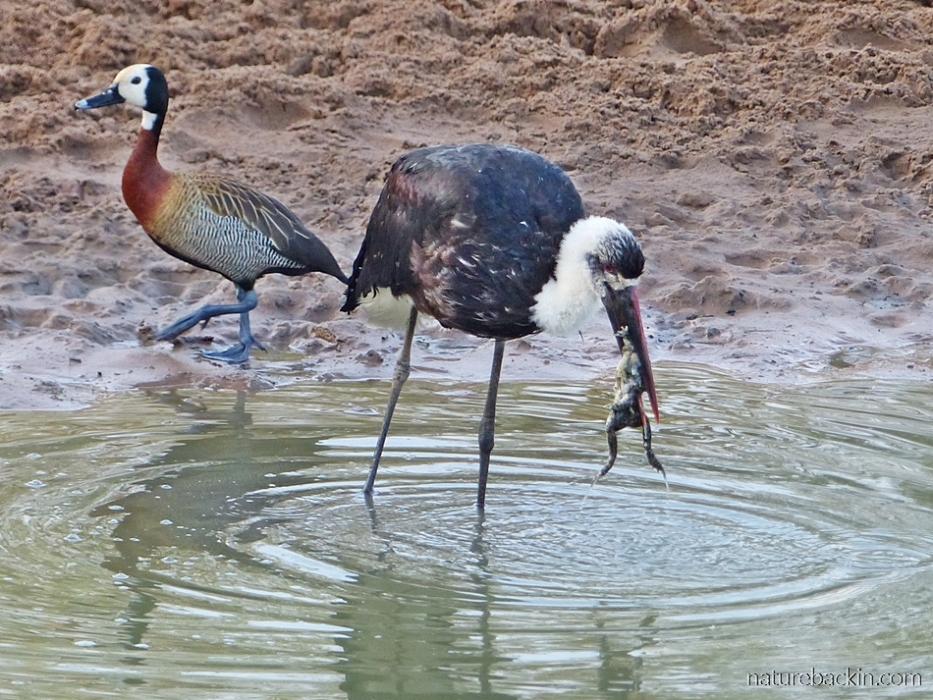
A woolly-necked stork snatched the opportunity to grab a frog as a white-faced whistling duck walks by. With its diversity of habitats Mkhuze Game Reserve hosts over 420 different species of birds
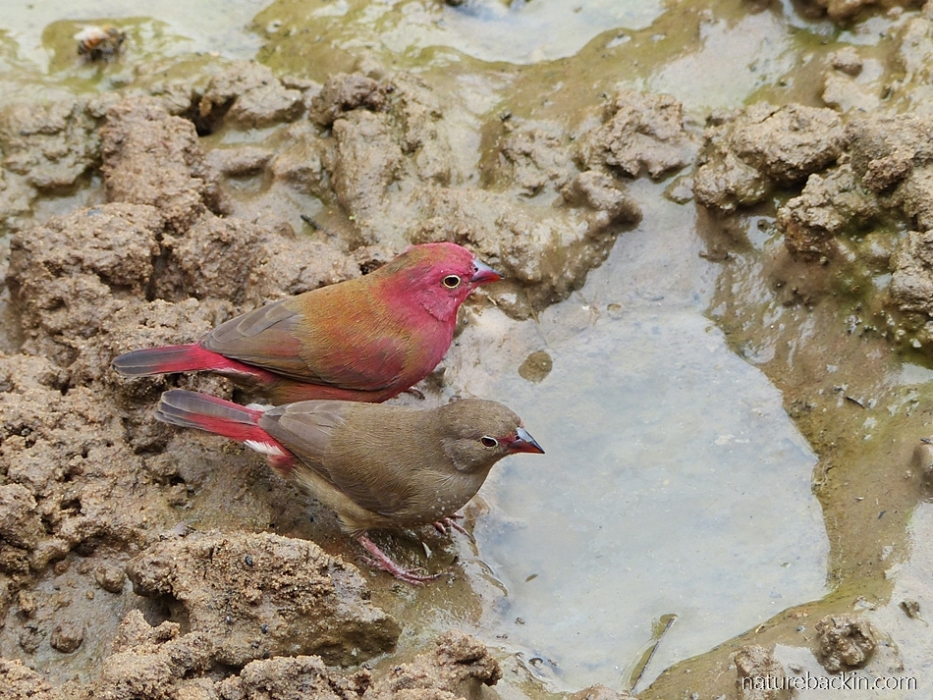
Small pools at the water’s edge made by the feet of the larger animals provide drinking places for birds, including this pair of red-billed firefinches
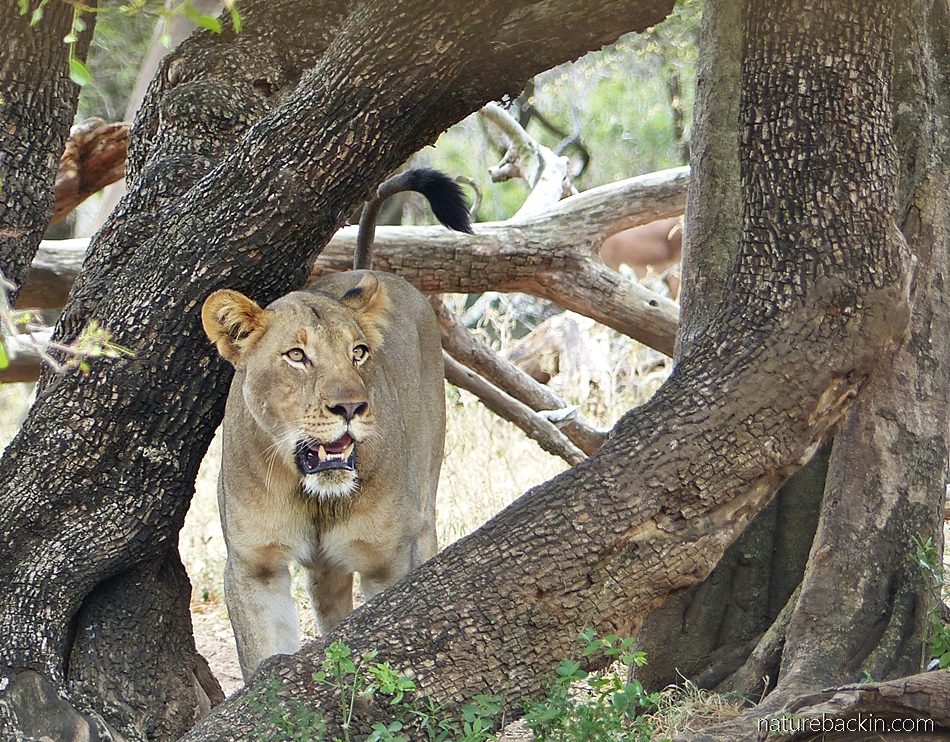
The apparently well-fed lionesses remained almost cheerily watchful. At one point one did stalk and then only halfheartedly chase a warthog. We saw vultures flying in and grouping to feed on the ground behind some nearby vegetation indicating the remains of what might have been the lions’ dinner from a previous night
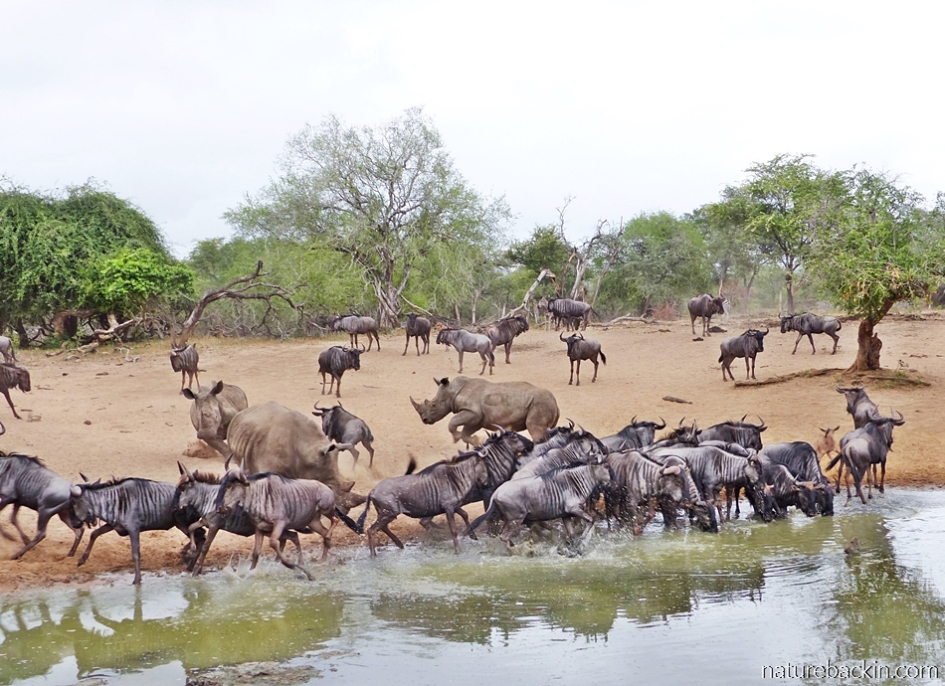
Time to go!
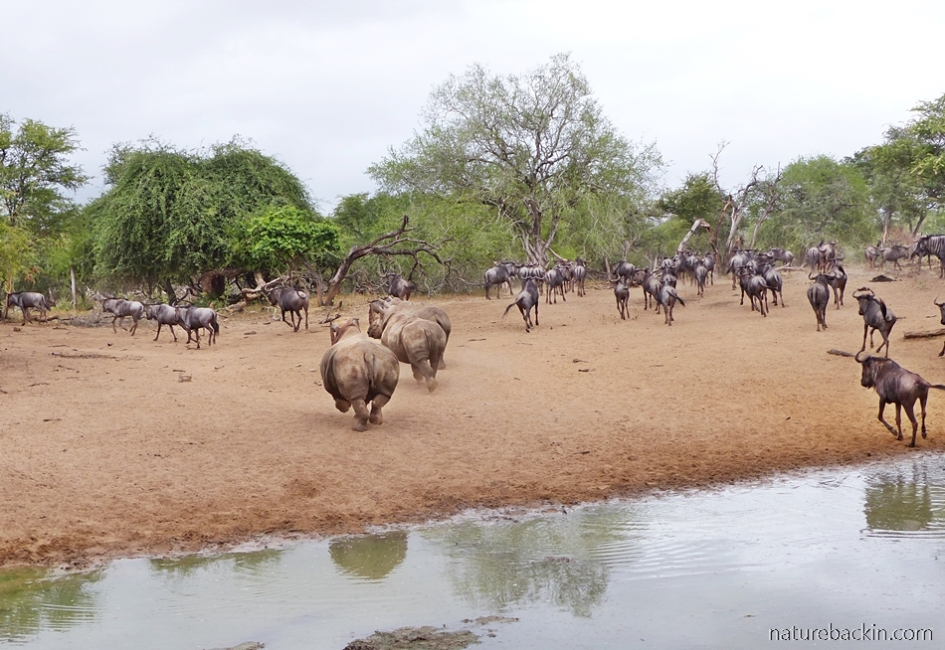
Most departures are more leisurely, but something spooked somebody and off they all went
Thank you for joining me in this piece of escapism to Mkhuze Game Reserve.
Currently, in the light of recent changes to South Africa’s lockdown regulations in response to the Covid-19 pandemic, plans are being made to ready the parks in the region and elsewhere in the country to enable private self-drive day visits to the parks. See the 2 June 2020 announcement from iSimangaliso Wetland Park here: https://isimangaliso.com/newsflash/covid-19-alert-level-3-announcement-by-isimangaliso-wetland-park/
Find out more about visiting Mkhuze Game Reserve
Far and Wild Safaries booking agency http://www.mkuzereservations.co.za; Ezemvelo KZN Wildlife: http://www.kznwildlife.com/Mantuma.html

Make a difference
The Covid-19 pandemic has impacted on so much, including on people and projects dedicated to wildlife conservation. Nikela raises funds for African wildlife conservation projects. It is a fundraising non-profit organisation on a mission to help people protecting nature, especially those doing wildlife conservation. Nikela is about helping people saving wildlife. To find out more go to https://www.nikela.org/
Posted by Carol









June 14, 2020 at 8:20 pm
What a fabulous experience and stunning photos. The atmosphere must have been unforgettable.
LikeLiked by 1 person
June 14, 2020 at 8:40 pm
The atmosphere is unforgettable – I wish the photos could also provide the soundtrack. Thank you Adele,
LikeLiked by 1 person
June 9, 2020 at 1:22 am
What an amazing treat this was. It’s such a pleasure to see the wildlife on your ‘corner’ of the globe. Amazing how they all seem to get along… though of course there’s always a chance one might someone’s dinner. Must keep everyone on their toes. I think best of all was the picture your father took. Somehow it makes it easier to imagine sitting there next to you in that blind.
Thanks for this unique sharing of your neighborhood! Very much appreciated.
LikeLiked by 1 person
June 14, 2020 at 8:35 pm
Thank you Gunta. It is interesting to see the different species intermingling as they come to drink and lovely to see how they mostly seem happy to accommodate each other in the process.
That old slide does capture something of the feeling of sitting in hide in anticipation of what might happen next,
LikeLike
June 8, 2020 at 1:47 pm
Carol, thank you so much for sharing these truly stunning shots. It has been a marvellous experience just enjoying your photographs; I can’t imagine how it must be to watch these arrivals and departures as they happen.
LikeLiked by 1 person
June 8, 2020 at 4:26 pm
Thanks Sandra. Sitting in the hide always creates an air of expectancy even when there are few animal visitors for long periods of time, and the sense of heightened awareness is much more intense than it ever is when driving around in a vehicle.
LikeLiked by 1 person
June 8, 2020 at 9:28 am
Astounding photographs. It felt as if I was there in the hide, watching with you. I am struggling to find words to express my wonder
LikeLiked by 1 person
June 8, 2020 at 4:23 pm
Thanks very much Mariss. Photos taken from the hide can have that sense of immediacy. We were fortunate with the softer light from the mostly overcast sky.
LikeLiked by 1 person
June 7, 2020 at 6:08 am
Your marvelous photos prove undeniably why KuMasinga is the best photographic hide in any of South Africa’s public reserves, Carol.
LikeLiked by 1 person
June 8, 2020 at 3:02 pm
Yes it is a wonderful hide. Great atmosphere. It is interesting how the vegetation changes over time, and last time we were there I missed the reeds that had been there previously. Possibly they were removed when the hide was renovated.
LikeLike
June 9, 2020 at 6:28 am
The reeds may also have been lost in the terrible drought of a few years ago. uMkhuze was especially hard hit.
LikeLiked by 1 person
June 11, 2020 at 8:50 pm
Yes that’s true. As far as I know they did manage to continue pumping water to the hide waterhole for the most part at least, even during the drought?
LikeLike
June 6, 2020 at 6:19 am
I feel like I just watched one of those David Attenborough documentaries. I must say I envy your sitting that hide watching all that wonderful wildlife. Interesting how the animals tend to bunch together as they drink. I suppose there’s a kind of security in that closeness. Also like how the scale of the animals comes out. Wildebeest are big animals, but they’re dwarfed by the rhinos.
LikeLiked by 1 person
June 6, 2020 at 8:13 pm
Thanks Graham. Of course there is a lot of time at the hide when no animals are visiting – and we see human visitors come and go (inside the hide!) without having the patience to wait. But there are times when it can almost seem frenetic at the waterhole.
Interesting what you say about the comparative scale of the animals coming out in these photos – I had not thought about that before. A lot of wildlife photography tends to focus on only one species in a frame I guess.
Indeed rhinos are incredibly large! I am always amazed at how light they are on their feet, even though there are times when they might appear to be quite lumbering.
LikeLike
June 7, 2020 at 4:44 am
I can’t imagine not being willing to sit awhile and see what shows up. What’s the point otherwise. The rhinos are awesome, like a semi-truck pulling into commuter traffic.
LikeLiked by 1 person
June 8, 2020 at 2:30 pm
I have wondered if watching nature programmes on TV make people think the animals should always be there!
Apt description of the rhinos 😊
LikeLiked by 1 person
June 9, 2020 at 4:14 am
I think you’re right. People miss the bit about ‘we sat in a mosquito-infested swamp, fending off crocodiles, for 48 hours to get this 15-second piece of video.’
LikeLiked by 1 person
June 11, 2020 at 8:48 pm
Indeed!
LikeLiked by 1 person
June 5, 2020 at 1:09 pm
What a lovely holiday I just took with you. 😉.
Thank you, it felt as if I was at the hide with you. What I would do for a trip like this right now.
Hang in there everyone. Stay Safe and healthy.
Blessings 💖
LikeLiked by 1 person
June 5, 2020 at 7:19 pm
Thank you Debs and I am pleased that I was able to convey something of that feeling of being at the hide with the animals coming and going. Hopefully we can all look forward to doing something like that in reality before too long. But as you say, in the meantime, we must just hang in there the best we can. You keep well and stay safe to xx
LikeLike
June 5, 2020 at 9:43 am
This virtual trip takes me back far too many years to our last visit to Mkhuze. I recall the waterholes being good places to see out the hottest times of the day, when patience would lend itself to wonderful sightings of animals coming down to drink. Your photographs are beautifully evocative.
LikeLiked by 1 person
June 5, 2020 at 7:06 pm
I am glad this evoked memories of your visits to Mkhuze, Anne. I hope that in the not too distant future you may be able to visit there again. It is such a wonderful place.
LikeLiked by 1 person
June 5, 2020 at 5:41 am
Utterly astonishing photos! What a privilege to have witnessed this diversity of creatures at such close quarters. That first photo of the zebras was particularly vivid and dramatic. Thanks for sharing them. Somehow it was so immediate, knowing you had taken them, rather than a television camera crew. I’m in awe.
LikeLiked by 1 person
June 5, 2020 at 7:04 pm
Thank you Margaret. I enjoyed revisiting the photos that I took on that visit. Sitting in a hide visited by so many photogenic visitors provided so many opportunities to try and capture something of it with the camera. While watching and listening we were almost as alert as some of those zebras – the experience really does heighten the senses.
LikeLiked by 1 person
June 6, 2020 at 6:55 am
I’ll bet. You’ve captured some wonderful memories there.
LikeLiked by 1 person
June 4, 2020 at 10:45 pm
What a wonderful ‘day in the life’ scenario. Beautiful animals… I can’t fathom how people can harm them.
LikeLiked by 1 person
June 5, 2020 at 6:55 pm
I am glad you enjoyed this time out with the beautiful animals of Mkhuze.
LikeLike